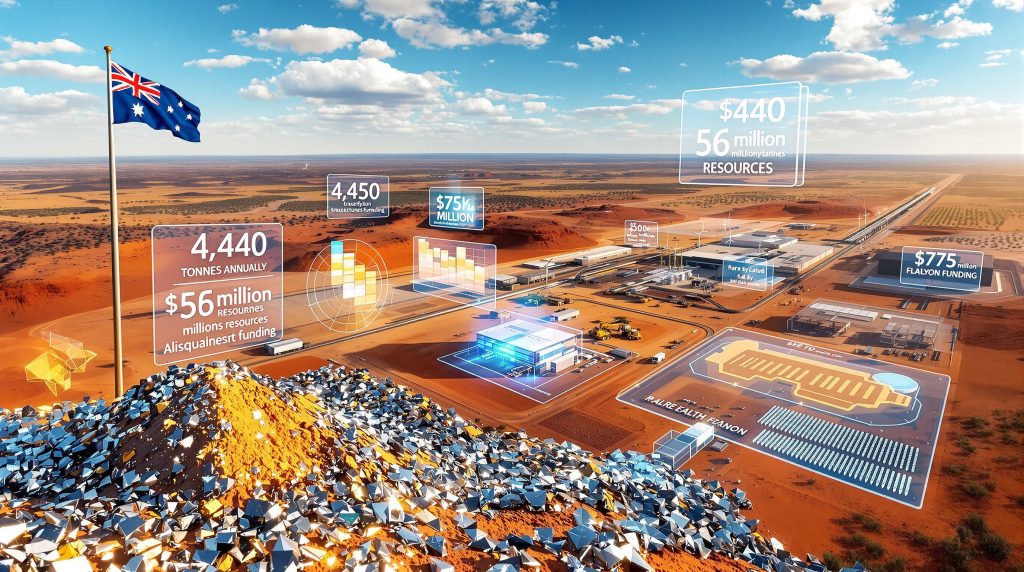The Nolans rare earth project represents one of Australia's most significant attempts to challenge China's dominance in critical mineral processing. Located in the Northern Territory, this development has captured international attention as Western nations seek to diversify their supply chains for materials essential to the critical minerals energy transition and advanced manufacturing.
Recent funding developments have positioned the project closer to construction, though market reactions demonstrate the complex dynamics facing rare earth developers outside of established Chinese supply chains.
Project Location and Resource Foundation
The Nolans rare earth project sits approximately 135 kilometres north of Alice Springs, strategically positioned within Australia's established mining infrastructure networks. This location provides access to existing transport corridors and renewable energy sources while maintaining proximity to key Asian markets without compromising Western supply chain objectives.
Resource Scale and Geological Composition
The underlying deposit contains approximately 56 million tonnes of mineral resources, averaging 2.6% total rare earth oxides (REO). Independent verification under JORC 2012 standards confirms this as one of the world's most substantial rare earth concentrations outside Chinese control.
Resource Classification Breakdown:
| Category | Volume/Grade |
|---|---|
| Total Mineral Resource | 56 million tonnes |
| Average REO Grade | 2.6% |
| Phosphate Content | 11% average |
| Initial Mine Life | 38 years |
| Extended Resource Potential | 45+ years |
The deposit's dual commodity nature, containing both rare earths and phosphate, provides potential revenue diversification that distinguishes it from single-commodity rare earth projects globally.
Production Targets and Market Positioning
Phase one operations target 4,440 tonnes annually of neodymium-praseodymium (NdPr) oxide, representing approximately 5-10% of global demand for these critical permanent magnet materials. This production scale positions the Nolans rare earth project among the most significant non-Chinese rare earth developments globally.
Critical Applications Driving Demand
Electric Vehicle Manufacturing:
- Permanent magnet motors requiring high-grade NdPr compounds
- Growing EV adoption rates increasing rare earth consumption
- Automotive industry seeking supply chain diversification
Renewable Energy Infrastructure:
- Wind turbine generators dependent on rare earth permanent magnets
- Offshore wind development accelerating demand growth
- Grid-scale energy storage systems requiring advanced materials
Advanced Defence Technologies:
- Military applications demanding secure supply chains
- Precision guidance systems and advanced electronics
- Strategic materials classification driving government support
Financial Structure and Funding Milestones
Recent capital raising activities secured AUD 475 million through institutional placement, with Hancock Prospecting contributing AUD 125 million as the lead strategic investor. Furthermore, this funding represents a crucial milestone for project development alongside the critical minerals order supporting strategic resource development, though it created significant share dilution impacts.
Comprehensive Funding Architecture
Current Funding Sources:
| Funding Type | Amount | Purpose |
|---|---|---|
| Institutional Placement | AUD 475 million | Construction preparation |
| US Debt Financing | US$775 million | Project development |
| Australian Government Support | AUD 200 million | Strategic backing |
| Export Credit Facilities | Under negotiation | Additional leverage |
The placement issued approximately 1.7 billion new shares at 28 cents each, creating 35-40% dilution for existing shareholders. This dilution explains immediate share price pressure despite the positive funding milestone, demonstrating how ASX capital raising impacts can overshadow project advancement in short-term market reactions.
Strategic Investor Significance
Hancock Prospecting's substantial investment signals confidence from Australia's largest mining conglomerate, bringing operational expertise and financial stability. In addition, this involvement provides credibility for ongoing debt negotiations with export credit agencies including Export Finance Australia, the Northern Australia Infrastructure Facility, and the US EXIM Bank.
Processing Technology and Operational Framework
The Nolans rare earth project employs conventional open-pit mining methods combined with sophisticated hydrometallurgical processing to separate rare earth elements and produce high-purity oxide products.
Multi-Stage Processing Approach
Beneficiation Phase:
- Initial ore concentration and preparation
- Physical separation techniques removing waste materials
- Grade enhancement for downstream processing
Hydrometallurgical Processing:
- Chemical separation of individual rare earth elements
- Solvent extraction circuits producing pure compounds
- Specialised precipitation and purification stages
By-Product Recovery:
- Phosphoric acid extraction generating additional revenue
- Estimated 144,000 tonnes annually of phosphoric acid production
- Integrated processing improving project economics
Infrastructure and Sustainability Considerations
The project integrates renewable energy systems to reduce carbon footprint, addressing growing environmental scrutiny of rare earth processing. Consequently, sustainable water management protocols and community engagement programs demonstrate commitment to responsible resource development, particularly regarding waste management solutions for rare earth processing.
Strategic Importance for Supply Chain Security
China currently controls over 80% of global rare earth processing capacity, creating strategic vulnerabilities for Western nations dependent on these materials for clean energy transitions and advanced technologies.
Geopolitical Context and Policy Support
The Nolans rare earth project participates in international frameworks designed to strengthen critical mineral supply chains, including:
- Minerals Security Partnership initiatives coordinating allied nation resource development
- US critical materials programmes supporting non-Chinese supply sources
- European Union raw materials strategies reducing import dependencies
- Australian Critical Minerals Strategy promoting domestic processing capabilities
"Supply chain diversification has become a national security priority for Western governments, creating policy support frameworks that benefit projects like Nolans through financial backing and streamlined regulatory processes."
Commercial Partnerships and Market Access
Binding offtake agreements with major international corporations provide revenue security and demonstrate market confidence in the project's viability. However, this is particularly important for junior mining investments seeking to establish credible revenue pathways.
Confirmed Strategic Partnerships
Automotive Sector Integration:
- Hyundai Motor Company: Long-term NdPr supply agreements
- Kia Corporation: Electric vehicle supply chain integration
- Combined agreements securing significant production allocation
Renewable Energy Applications:
- Siemens Gamesa: Wind turbine generator magnet requirements
- European renewable energy market access
- Long-term pricing stability through contract structures
These partnerships provide revenue visibility while demonstrating end-user demand for non-Chinese rare earth sources, supporting project financing and development timelines.
Development Timeline and Construction Planning
Following recent funding milestones, the Nolans rare earth project targets a final investment decision by early 2026, with construction commencement shortly thereafter.
What Are the Projected Development Phases?
Pre-Construction Phase (2025-2026):
- Final investment decision completion
- Remaining debt financing arrangements
- Detailed engineering and procurement contracts
- Environmental and regulatory approvals finalisation
Construction Period (2026-2029):
- Three-year construction timeline
- Processing plant and infrastructure development
- Workforce recruitment and training programmes
- Progressive commissioning activities
Production Ramp-Up (2029-2031):
- Gradual capacity increase to full production
- Product quality optimisation
- Market penetration and customer relationship development
- Potential expansion planning for Phase 2
Economic Impact and Employment Generation
The operation expects to create over 600 direct jobs during construction and operational phases, with substantial indirect employment throughout the Northern Territory economy. For instance, the project will leverage both local expertise and specialised international knowledge.
Regional Development Benefits
Employment Creation:
| Category | Impact |
|---|---|
| Direct Employment | 600+ positions |
| Indirect Regional Jobs | 1,200+ estimated |
| Construction Workforce | Peak 800+ personnel |
| Specialised Technical Roles | High-skill opportunities |
Revenue Generation Potential:
With NdPr oxide prices typically ranging $50-80 per kilogram, annual production could generate $220-350 million in direct revenue before accounting for phosphoric acid by-product sales, representing significant export value for Australia.
Global Competitive Positioning
The Nolans rare earth project distinguishes itself from most global competitors through its scale, integration, and strategic location advantages. Furthermore, the project benefits from receiving significant government funding through various Australian infrastructure programmes.
Comparative Analysis Framework
Resource Scale Advantages:
- Larger than most Western rare earth projects
- Superior ore grades compared to many global deposits
- Long mine life supporting sustained production
Geographic and Infrastructure Benefits:
- Proximity to Asian demand centres
- Established mining jurisdiction with supportive regulations
- Access to skilled workforce and service providers
- Transport infrastructure connections to export facilities
Government and Policy Support:
- Stronger policy backing than many international alternatives
- Integration with national critical minerals strategies
- Export finance and development agency support
- Alignment with allied nation supply chain objectives
Risk Factors and Investment Considerations
Despite positive project fundamentals, several risk factors require careful consideration for potential investors and stakeholders.
What Are the Construction and Operational Risks?
Technical Implementation:
- Complex hydrometallurgical processing requiring specialised expertise
- Construction delays potential given project scale and remote location
- Technology risks despite proven processing methodologies
Market and Financial Factors:
- Rare earth price volatility impacting project economics
- Financing completion risks for remaining debt requirements
- Currency exposure between Australian costs and US dollar revenues
Regulatory and Environmental Considerations:
- Environmental approvals and ongoing compliance requirements
- Indigenous land use agreements and community relationships
- Water usage and waste management regulatory frameworks
"Rare earth projects involve significant technical, market, and execution risks. The information presented here is for educational purposes and should not be considered investment advice. Potential investors should conduct thorough due diligence and consult qualified financial advisors before making investment decisions."
Future Expansion and Growth Potential
The resource base supports potential expansion to 10,000 tonnes annual NdPr production, effectively doubling initial capacity and market share contribution.
Phase 2 Development Scenarios
Production Expansion Pathways:
- Additional processing circuits increasing throughput capacity
- Enhanced product mix including higher-value separated rare earth compounds
- Downstream processing opportunities for permanent magnet manufacturing
- Integration with battery material supply chains
Technology Evolution Opportunities:
- Advanced extraction techniques improving recovery rates
- Automated processing systems reducing operational costs
- Sustainable processing innovations addressing environmental concerns
- Integration with renewable energy systems for carbon-neutral operations
Market Dynamics Supporting Growth
Growing demand for electric vehicles, renewable energy infrastructure, and advanced electronics creates favourable long-term market conditions for rare earth producers with reliable Western supply capabilities.
The Nolans rare earth project represents a potentially transformative development for global rare earth supply chains, combining substantial resources, strategic location, government support, and commercial partnerships to challenge established market structures dominated by Chinese processing capabilities.
Ready to Capitalise on the Next Critical Minerals Discovery?
Discovery Alert's proprietary Discovery IQ model delivers real-time alerts on significant ASX mineral discoveries, instantly empowering subscribers to identify actionable opportunities ahead of the broader market. Understand why historic discoveries can generate substantial returns by exploring major mineral breakthroughs, then begin your 30-day free trial today to position yourself ahead of the market.




